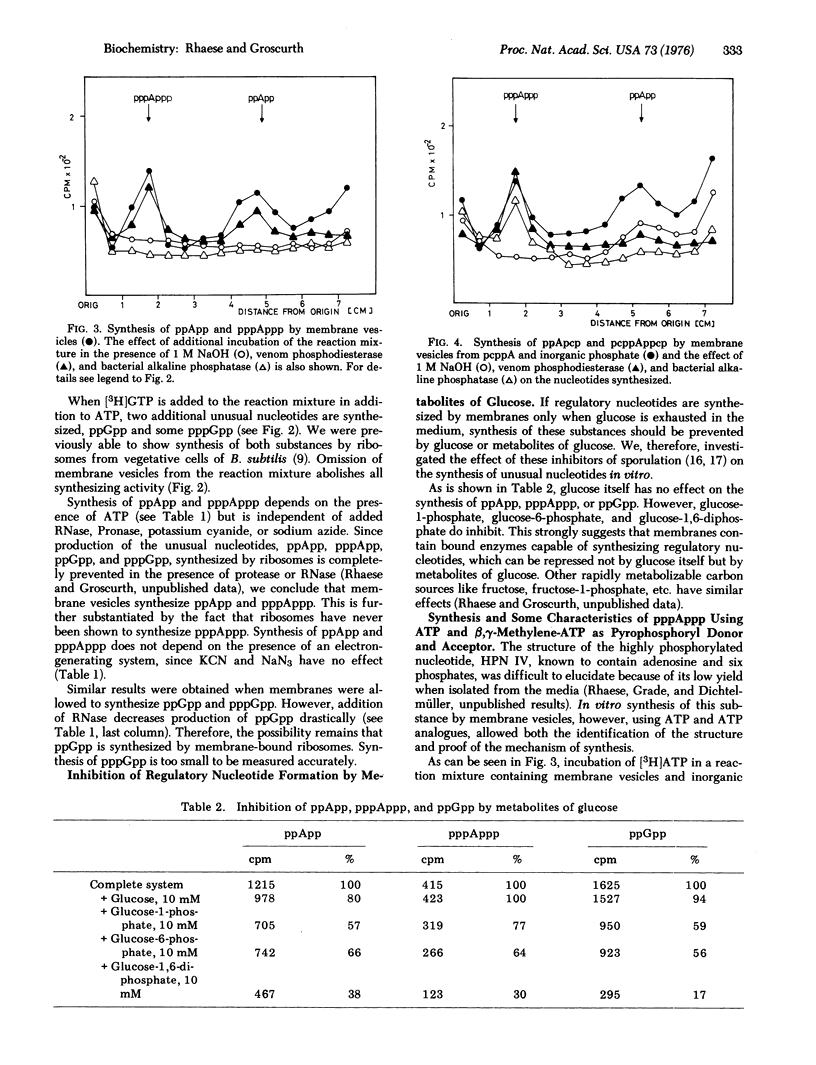Abstract
A model explaining the mechanism of initiation of differentiation is presented. It is based on the finding that sporulation in B. subtilis can be induced by the same nutrient deficiencies that also induce the synthesis of highly phosphorylated nucleotides. Two of these nucleotides are synthesized by membrane vesicles. Synthesis can be inhibited by the same metabolites of glucose that also inhibit sporulation. It is concluded, therefore, that the plasma membrane synthesizes unusual nucleotides in response to nutrient deficiencies. By several as yet unknown steps, these nucleotides then cuase changes in the metabolism of the organism leading to the formation of spores. Both structure and mechanism of synthesis of adenosine hexaphosphate, pppAppp, have been elucidated by use of ATP analogues.
Full text
PDF




Selected References
These references are in PubMed. This may not be the complete list of references from this article.
- Cashel M., Gallant J. Two compounds implicated in the function of the RC gene of Escherichia coli. Nature. 1969 Mar 1;221(5183):838–841. doi: 10.1038/221838a0. [DOI] [PubMed] [Google Scholar]
- Cashel M., Kalbacher B. The control of ribonucleic acid synthesis in Escherichia coli. V. Characterization of a nucleotide associated with the stringent response. J Biol Chem. 1970 May 10;245(9):2309–2318. [PubMed] [Google Scholar]
- Freese E., Ichikawa T., O Y. K., Freese E. B., Prasad C. Deficiencies or excesses of metabolites interfering with differentiation. Proc Natl Acad Sci U S A. 1974 Oct;71(10):4188–4193. doi: 10.1073/pnas.71.10.4188. [DOI] [PMC free article] [PubMed] [Google Scholar]
- Gallant J., Margason G. Amino acid control of messenger ribonucleic acid synthesis in Bacillus subtilis. J Biol Chem. 1972 Apr 25;247(8):2289–2294. [PubMed] [Google Scholar]
- Holmes P. K., Levinson H. S. Metabolic requirements for microcycle sporogenesis of Bacillus megaterium. J Bacteriol. 1967 Aug;94(2):434–440. doi: 10.1128/jb.94.2.434-440.1967. [DOI] [PMC free article] [PubMed] [Google Scholar]
- Konings W. N., Freese E. Amino acid transport in membrane vesicles of Bacillus subtilis. J Biol Chem. 1972 Apr 25;247(8):2408–2418. [PubMed] [Google Scholar]
- MacKechnie I., Hanson R. S. Microcycle sporogenesis of Bacillus cereus in a chemically defined medium. J Bacteriol. 1968 Feb;95(2):355–359. doi: 10.1128/jb.95.2.355-359.1968. [DOI] [PMC free article] [PubMed] [Google Scholar]
- Rhaese H. J., Dichtelmüller H., Grade R. Studies on the control of development. Accumulation of guanosine tetraphosphate and pentaphosphate in response to inhibition of protein synthesis in Bacillus subtilis. Eur J Biochem. 1975 Aug 15;56(2):385–392. doi: 10.1111/j.1432-1033.1975.tb02244.x. [DOI] [PubMed] [Google Scholar]
- Rhaese H. J., Groscurth R. Studies on the control of development. In vitro synthesis of HPN and MS nucleotides by ribosomes from either sporulating or vegetative cells of Bacillus subtilis. FEBS Lett. 1974 Aug 15;44(1):87–93. doi: 10.1016/0014-5793(74)80312-1. [DOI] [PubMed] [Google Scholar]
- Rhaese H. J. Studies on the control of development synthesis of regulatory nucleotides, HPN and MS, in mammalian cells in tissue cultures. FEBS Lett. 1975 Apr 15;53(1):113–118. doi: 10.1016/0014-5793(75)80696-x. [DOI] [PubMed] [Google Scholar]
- Schaeffer P., Millet J., Aubert J. P. Catabolic repression of bacterial sporulation. Proc Natl Acad Sci U S A. 1965 Sep;54(3):704–711. doi: 10.1073/pnas.54.3.704. [DOI] [PMC free article] [PubMed] [Google Scholar]


